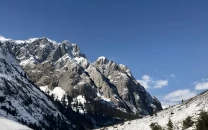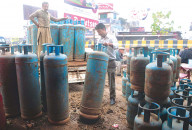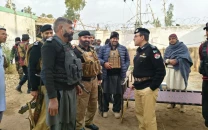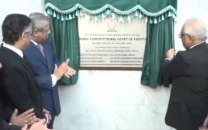The camped and the stranded, all await rations
Thousands trapped in submerged areas accuse the government of neglect.

Thursday was the 16th consecutive day he spent by the roadside, waiting for relief goods.
“So far, I have managed to get hold of a ration bag only twice,” says Samejo, visibly disappointed over the distribution process.
Over 200 villages including Samejo’s were inundated by overflows from Guni Fuleli outfall drain, known locally as Ameer Shah Sim Nullah, in the second spell of monsoon rains which started August 30th.
The government staff delivers insufficient rations to peo resident Haji Dao Chandio, accusing the government of neglecting those marooned in inaccessible areas.
“While the government claims it is distributing rations in relief camps, it overlooks the majority of the affected population that is either still in their villages or lives on the roads,” Chandio says.
That neglect is now fuelling frustration.
Inaccessible areas
For its part, the district government, assisted by the national and provincial disaster management authorities, claims to have reached every nook and cranny of Badin, and distributed over 168,000 ration bags by September 13.
A government official from Badin, however, admitted that besides relief camps, their reach is limited to areas with road access. Non-governmental organisations (NGOs) also cite the inaccessibility issue.
“We face a logistical problem reaching far-off communities,” admits Ajmad Jamal, spokesperson for the World Food Program (WFP).
The WFP, according to Jamal, has been given responsibility for food distribution in four union councils out of Badin’s 46. “The district administration kept the accessibility in consideration while assigning these areas,” he said.
Alternative routes
Residents of ‘inaccessible’ villages, however, dispute the official claims, saying there are several ways to reach the stranded people.
Locals also say that relief workers are either unaware of, or avoid taking detours, to reach areas they categorise as ‘inaccessible’.
Accessible, yet neglected
Those stranded far away are not the only ones neglected.
Maula Bux Sami, a young scheduled caste Hindu, lived in a relief camp at Army Model School which was visited by Prime Minister Yousaf Raza Gilani on August 15.
On that day, he says, his family of eight received a sack full of ration and with a medical camp and classroom facilities available, hoped to pass their days of displacement in comparative ease.
They did not expect that they would have to survive on that ration for over two weeks and would be driven out of their refuge by a second round of monsoon rains which began August 30 and continued intermittently till September 12.
Sami now lives in a tent outside that camp and says that he managed to secure another supply of foodstuff nearly a month after the first one.
His account was corroborated by a police constable deputed at the camp.
Published in The Express Tribune, September 17th, 2011.



















COMMENTS
Comments are moderated and generally will be posted if they are on-topic and not abusive.
For more information, please see our Comments FAQ